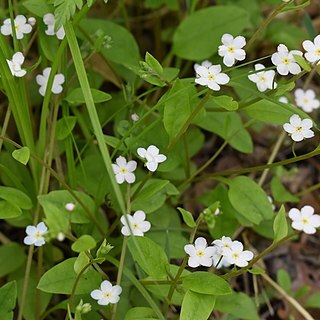Herbs perennial, sparsely short strigose, glabrescent, or more densely sericeous-strigose. Stems several, cespitose, erect becoming creeping, to 50 cm tall, rooting from apex or producing rooting branches from axils of upper leaves. Petiole of basal leaves to 18 cm; leaf blade oblong-ovate to ovate, 1-4 cm, rarely longer, abaxially finely short strigose, base cordate to rounded, apex acute; midvein prominent, lateral veins obscure; stem leaves short petiolate. Pedicel to 2 cm in fruit, densely short strigose. Flowers solitary, above stem leaf axils. Calyx 5-parted; lobes lanceolate to broadly ovate, ca. 3 mm, to 5 mm in fruit, apex acute. Corolla light blue or white; tube ca. 1.2-2 mm; throat appendages ca. 0.5 mm, pubescent; limb 6-8(-12) mm wide; lobes divaricate, oblong. Anthers elliptic, ca. 0.5 mm, apex obtuse. Mature nutlets brown, oblique subulate, trigonous-tetrahedral, pubescent, adaxial bottom surface slightly smaller than 2 lateral surfaces; abaxial surfaces flat, rhomboid to rhomboid-ovate, ca. 2 mm, margin narrowly ribbed, apex acute; stipe ca. 0.8 mm, curved. Fl. Jun-Aug, fr. Jul-Sep.
More
A herb. It keeps growing from year to year. There are several stems. They are 50 cm tall. Rooting branches develop from the upper sections. The leaves at the base have leaf stalks 18 cm long. The leaves are oval and 1-4 cm long. The flowers occur singly above the axils of the leaves on the stem. They are light blue of white.
A rare plant in the mountains of S. Japan. Found on damp rocks in Siberia. Forest margins, thickets, brookside meadows in N. China.
More
It is a temperate plant. It grows on the edges of forests and in meadows.

